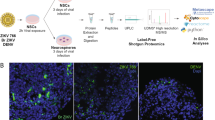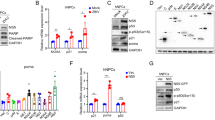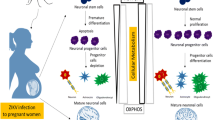Abstract
The Zika virus (ZIKV) outbreaks and its co-relation with microcephaly have become a global health concern. It is primarily transmitted by a mosquito, but can also be transmitted from an infected mother to her fetus causing impairment in brain development, leading to microcephaly. However, the underlying molecular mechanism of ZIKV-induced microcephaly is poorly understood. In this study, we explored the role of ZIKV non-structural protein NS4A and NS4B in ZIKV pathogenesis in a well-characterized primary culture of human fetal neural stem cells (fNSCs). We observed that the co-transfection of NS4A and NS4B altered the neural stem cell fate by arresting proliferation and inducing premature neurogenesis. NS4A + NS4B transfection in fNSCs increased autophagy and dysregulated notch signaling. Further, it also altered the regulation of downstream genes controlling cell proliferation. Additionally, we reported that 3 methyl-adenine (3-MA), a potent autophagy inhibitor, attenuated the deleterious effects of NS4A and NS4B as evidenced by the rescue in Notch1 expression, enhanced proliferation, and reduced premature neurogenesis. Our attempts to understand the mechanism of autophagy induction indicate the involvement of mitochondrial fission and ROS. Collectively, our findings highlight the novel role of NS4A and NS4B in mediating NSC fate alteration through autophagy-mediated notch degradation. The study also helps to advance our understanding of ZIKV-induced neuropathogenesis and suggests autophagy as a potential target for anti-ZIKV therapeutic intervention.








Similar content being viewed by others
Data Availability
All data generated during this study are available from the corresponding author on reasonable request.
References
Wen Z, Song H, Ming G (2017) How does Zika virus cause microcephaly? Genes Dev 31:849–861. https://doi.org/10.1101/gad.298216.117
Ss P, S D, S T, et al (2017) Overview on the current status of Zika virus pathogenesis and animal related research. J Neuroimmune Pharmacol : Off J Soc NeuroImmune Pharmacol 12. https://doi.org/10.1007/s11481-017-9743-8
Dong S, **ao MZX, Liang Q (2023) Modulation of cellular machineries by Zika virus-encoded proteins. J Med Virol 95:e28243. https://doi.org/10.1002/jmv.28243
Liang Q, Luo Z, Zeng J et al (2016) Zika Virus NS4A and NS4B proteins deregulate Akt-mTOR signaling in human fetal neural stem cells to inhibit neurogenesis and induce autophagy. Cell Stem Cell 19:663–671. https://doi.org/10.1016/j.stem.2016.07.019
Miner JJ, Diamond MS (2017) Zika virus pathogenesis and tissue tropism. Cell Host Microbe 21:134–142. https://doi.org/10.1016/j.chom.2017.01.004
Mlakar J, Korva M, Tul N et al (2016) Zika virus associated with microcephaly. N Engl J Med 374:951–958. https://doi.org/10.1056/NEJMoa1600651
Carteaux G, Maquart M, Bedet A et al (2016) Zika virus associated with meningoencephalitis. N Engl J Med 374:1595–1596. https://doi.org/10.1056/NEJMc1602964
Mécharles S, Herrmann C, Poullain P et al (2016) Acute myelitis due to Zika virus infection. The Lancet 387:1481. https://doi.org/10.1016/S0140-6736(16)00644-9
Styczynski AR, Malta JMAS, Krow-Lucal ER et al (2017) Increased rates of Guillain-Barré syndrome associated with Zika virus outbreak in the Salvador metropolitan area, Brazil. PLoS Negl Trop Dis 11:e0005869. https://doi.org/10.1371/journal.pntd.0005869
Xu D, Li C, Qin C-F, Xu Z (2019) Update on the animal models and underlying mechanisms for ZIKV-induced microcephaly. Annu Rev Virol 6:459–479. https://doi.org/10.1146/annurev-virology-092818-015740
Barbelanne M, Tsang WY (2014) Molecular and cellular basis of autosomal recessive primary microcephaly. Biomed Res Int 2014:547986. https://doi.org/10.1155/2014/547986
McDonell LM, Warman Chardon J, Schwartzentruber J et al (2014) The utility of exome sequencing for genetic diagnosis in a familial microcephaly epilepsy syndrome. BMC Neurol 14:22. https://doi.org/10.1186/1471-2377-14-22
Tanaka AJ, Cho MT, Millan F et al (2015) Mutations in SPATA5 are associated with microcephaly, intellectual disability, seizures, and hearing loss. Am J Hum Genet 97:457–464. https://doi.org/10.1016/j.ajhg.2015.07.014
Merfeld E, Ben-Avi L, Kennon M, Cerveny KL (2017) Potential mechanisms of Zika-linked microcephaly. Wiley Interdiscip Rev Dev Biol 6:e273. https://doi.org/10.1002/wdev.273
Garcez PP, Loiola EC, Madeiro da Costa R et al (2016) Zika virus impairs growth in human neurospheres and brain organoids. Science 352:816–818. https://doi.org/10.1126/science.aaf6116
Qian X, Nguyen HN, Song MM et al (2016) Brain-region-specific organoids using mini-bioreactors for modeling ZIKV exposure. Cell 165:1238–1254. https://doi.org/10.1016/j.cell.2016.04.032
Tang H, Hammack C, Ogden SC et al (2016) Zika virus infects human cortical neural progenitors and attenuates their growth. Cell Stem Cell 18:587–590. https://doi.org/10.1016/j.stem.2016.02.016
Li C, Xu D, Ye Q et al (2016) Zika virus disrupts neural progenitor development and leads to microcephaly in mice. Cell Stem Cell 19:120–126. https://doi.org/10.1016/j.stem.2016.04.017
Shao Q, Herrlinger S, Yang S-L et al (2016) Zika virus infection disrupts neurovascular development and results in postnatal microcephaly with brain damage. Development 143:4127–4136. https://doi.org/10.1242/dev.143768
Wu K-Y, Zuo G-L, Li X-F et al (2016) Vertical transmission of Zika virus targeting the radial glial cells affects cortex development of offspring mice. Cell Res 26:645–654. https://doi.org/10.1038/cr.2016.58
Yuan L, Huang X-Y, Liu Z-Y et al (2017) A single mutation in the prM protein of Zika virus contributes to fetal microcephaly. Science 358:933–936. https://doi.org/10.1126/science.aam7120
Bhagat R, Prajapati B, Narwal S et al (2018) Zika virus E protein alters the properties of human fetal neural stem cells by modulating microRNA circuitry. Cell Death Differ 25:1837–1854. https://doi.org/10.1038/s41418-018-0163-y
Cugola FR, Fernandes IR, Russo FB et al (2016) The Brazilian Zika virus strain causes birth defects in experimental models. Nature 534:267–271. https://doi.org/10.1038/nature18296
Goodfellow FT, Willard KA, Wu X et al (2018) Strain-dependent consequences of Zika virus infection and differential impact on neural development. Viruses 10:E550. https://doi.org/10.3390/v10100550
Dong X, Levine B (2013) Autophagy and viruses: adversaries or allies? J Innate Immun 5:480–493. https://doi.org/10.1159/000346388
Chiramel AI, Best SM (2018) Role of autophagy in Zika virus infection and pathogenesis. Virus Res 254:34–40. https://doi.org/10.1016/j.virusres.2017.09.006
Ebrahimi-Fakhari D, Saffari A, Wahlster L et al (2016) Congenital disorders of autophagy: an emerging novel class of inborn errors of neuro-metabolism. Brain 139:317–337. https://doi.org/10.1093/brain/awv371
Iossifov I, Ronemus M, Levy D et al (2012) De Novo Gene disruptions in children on the autistic spectrum. Neuron 74:285–299. https://doi.org/10.1016/j.neuron.2012.04.009
Courchesne E, Pierce K, Schumann CM et al (2007) Map** early brain development in autism. Neuron 56:399–413. https://doi.org/10.1016/j.neuron.2007.10.016
Wu X, Fleming A, Ricketts T et al (2016) Autophagy regulates Notch degradation and modulates stem cell development and neurogenesis. Nat Commun 7:10533. https://doi.org/10.1038/ncomms10533
Venkatesh K, Reddy LVK, Abbas S et al (2017) NOTCH Signaling Is Essential for Maturation, Self-Renewal, and Tri-Differentiation of In Vitro Derived Human Neural Stem Cells. Cell Reprogram 19:372–383. https://doi.org/10.1089/cell.2017.0009
Barth S, Glick D, Macleod KF (2010) Autophagy: assays and artifacts. J Pathol 221:117–124. https://doi.org/10.1002/path.2694
Gao C, Cao W, Bao L et al (2010) Autophagy negatively regulates Wnt signalling by promoting Dishevelled degradation. Nat Cell Biol 12:781–790. https://doi.org/10.1038/ncb2082
Zhou Z-D, Kumari U, **ao Z-C, Tan E-K (2010) Notch as a molecular switch in neural stem cells. IUBMB Life 62:618–623. https://doi.org/10.1002/iub.362
Wu Y-T, Tan H-L, Shui G et al (2010) Dual role of 3-methyladenine in modulation of autophagy via different temporal patterns of inhibition on class I and III Phosphoinositide 3-Kinase. J Biol Chem 285:10850–10861. https://doi.org/10.1074/jbc.M109.080796
Scherz-Shouval R, Elazar Z (2011) Regulation of autophagy by ROS: physiology and pathology. Trends Biochem Sci 36:30–38. https://doi.org/10.1016/j.tibs.2010.07.007
Khacho M, Clark A, Svoboda DS et al (2016) Mitochondrial dynamics impacts stem cell identity and fate decisions by regulating a nuclear transcriptional program. Cell Stem Cell 19:232–247. https://doi.org/10.1016/j.stem.2016.04.015
Marbán-Castro E, Goncé A, Fumadó V et al (2021) Zika virus infection in pregnant women and their children: A review. Eur J Obstet Gynecol Reprod Biol 265:162–168. https://doi.org/10.1016/j.ejogrb.2021.07.012
Dang JW, Tiwari SK, Qin Y, Rana TM (2019) Genome-wide integrative analysis of Zika-virus-infected neuronal stem cells reveals roles for MicroRNAs in cell cycle and stemness. Cell Rep 27:3618-3628.e5. https://doi.org/10.1016/j.celrep.2019.05.059
Rothan HA, Fang S, Mahesh M, Byrareddy SN (2019) Zika virus and the metabolism of neuronal cells. Mol Neurobiol 56:2551–2557. https://doi.org/10.1007/s12035-018-1263-x
Garza-Lombó C, Gonsebatt ME (2016) Mammalian target of rapamycin: its role in early neural development and in adult and aged brain function. Front Cell Neurosci 10:157. https://doi.org/10.3389/fncel.2016.00157
Phan TP, Holland AJ (2021) Time is of the essence: the molecular mechanisms of primary microcephaly. Genes Dev 35:1551–1578. https://doi.org/10.1101/gad.348866.121
Sotthibundhu A, Promjuntuek W, Liu M et al (2018) Roles of autophagy in controlling stem cell identity: a perspective of self-renewal and differentiation. Cell Tissue Res 374:205–216. https://doi.org/10.1007/s00441-018-2829-7
Eskelinen E-L (2006) Roles of LAMP-1 and LAMP-2 in lysosome biogenesis and autophagy. Mol Aspects Med 27:495–502. https://doi.org/10.1016/j.mam.2006.08.005
Lasky JL, Wu H (2005) Notch signaling, brain development, and human disease. Pediatr Res 57:104R-109R. https://doi.org/10.1203/01.PDR.0000159632.70510.3D
Ohtsuka T, Ishibashi M, Gradwohl G et al (1999) Hes1 and Hes5 as notch effectors in mammalian neuronal differentiation. EMBO J 18:2196–2207. https://doi.org/10.1093/emboj/18.8.2196
de la Pompa JL, Wakeham A, Correia KM et al (1997) Conservation of the Notch signalling pathway in mammalian neurogenesis. Development 124:1139–1148. https://doi.org/10.1242/dev.124.6.1139
Kageyama R, Ohtsuka T (1999) The Notch-Hes pathway in mammalian neural development. Cell Res 9:179–188. https://doi.org/10.1038/sj.cr.7290016
Tomita K, Ishibashi M, Nakahara K et al (1996) Mammalian hairy and Enhancer of split homolog 1 regulates differentiation of retinal neurons and is essential for eye morphogenesis. Neuron 16:723–734. https://doi.org/10.1016/s0896-6273(00)80093-8
Ishibashi M, Ang SL, Shiota K et al (1995) Targeted disruption of mammalian hairy and Enhancer of split homolog-1 (HES-1) leads to up-regulation of neural helix-loop-helix factors, premature neurogenesis, and severe neural tube defects. Genes Dev 9:3136–3148. https://doi.org/10.1101/gad.9.24.3136
Imayoshi I, Kageyama R (2014) bHLH factors in self-renewal, multipotency, and fate choice of neural progenitor cells. Neuron 82:9–23. https://doi.org/10.1016/j.neuron.2014.03.018
Ledur PF, Karmirian K, da Pedrosa C, SG, et al (2020) Zika virus infection leads to mitochondrial failure, oxidative stress and DNA damage in human iPSC-derived astrocytes. Sci Rep 10:1218. https://doi.org/10.1038/s41598-020-57914-x
**e X, Shu R, Yu C, et al (2022) Mammalian AKT, the emerging roles on mitochondrial function in diseases. Aging Dis 13:157–174. https://doi.org/10.14336/AD.2021.0729
Acknowledgements
We acknowledge the technical assistance from Mr. Naushad Alam and Mr. DL Meena of NBRC. Mr. Naushad also helped in performing some assays. We are thankful to Dr. Shyamala Mani, IISc, India for providing Expression vectors for the Zika virus proteins. We highly acknowledge the fellowship from Council of Scientific and Industrial Research (CSIR) to Bindu and Hriday Shanker Pandey and financial support from NBRC core funds to Prof. Pankaj Seth. We also acknowledge the support of the facilities provided under the Biotechnology Information System Network (BTISNET) grant, Department of Biotechnology (DBT), India, and Distributed Information Centre at NBRC, Manesar, India.
Funding
This study was supported by the Council of Scientific and Industrial Research (CSIR), Department of Biotechnology (DBT), and National Brain Research Centre (NBRC) core fund.
Author information
Authors and Affiliations
Contributions
Bindu designed the study, performed experiments, analyzed the data, and wrote the manuscript. Hriday Shanker Pandey helped in performing rescue experiments and writing the manuscript. Pankaj Seth helped in designing experiments, interpretation of data, and finalizing the manuscript.
Corresponding author
Ethics declarations
Ethical Approval
Strict guidelines of institutional Human ethics and stem cell research committee of NBRC, India in compliance with recommendations of the Indian Council of Medical Research (ICMR) and Department of Biotechnology (DBT), India were followed for isolation of Neural stem cells from aborted human fetus.
Consent to Participate
Not applicable.
Consent to Publish
Not applicable.
Competing Interest
The authors declare no competing interests.
Additional information
Publisher's Note
Springer Nature remains neutral with regard to jurisdictional claims in published maps and institutional affiliations.
Supplementary Information
Below is the link to the electronic supplementary material.
Rights and permissions
Springer Nature or its licensor (e.g. a society or other partner) holds exclusive rights to this article under a publishing agreement with the author(s) or other rightsholder(s); author self-archiving of the accepted manuscript version of this article is solely governed by the terms of such publishing agreement and applicable law.
About this article
Cite this article
Bindu, Pandey, H.S. & Seth, P. Interplay Between Zika Virus-Induced Autophagy and Neural Stem Cell Fate Determination. Mol Neurobiol (2023). https://doi.org/10.1007/s12035-023-03704-1
Received:
Accepted:
Published:
DOI: https://doi.org/10.1007/s12035-023-03704-1




